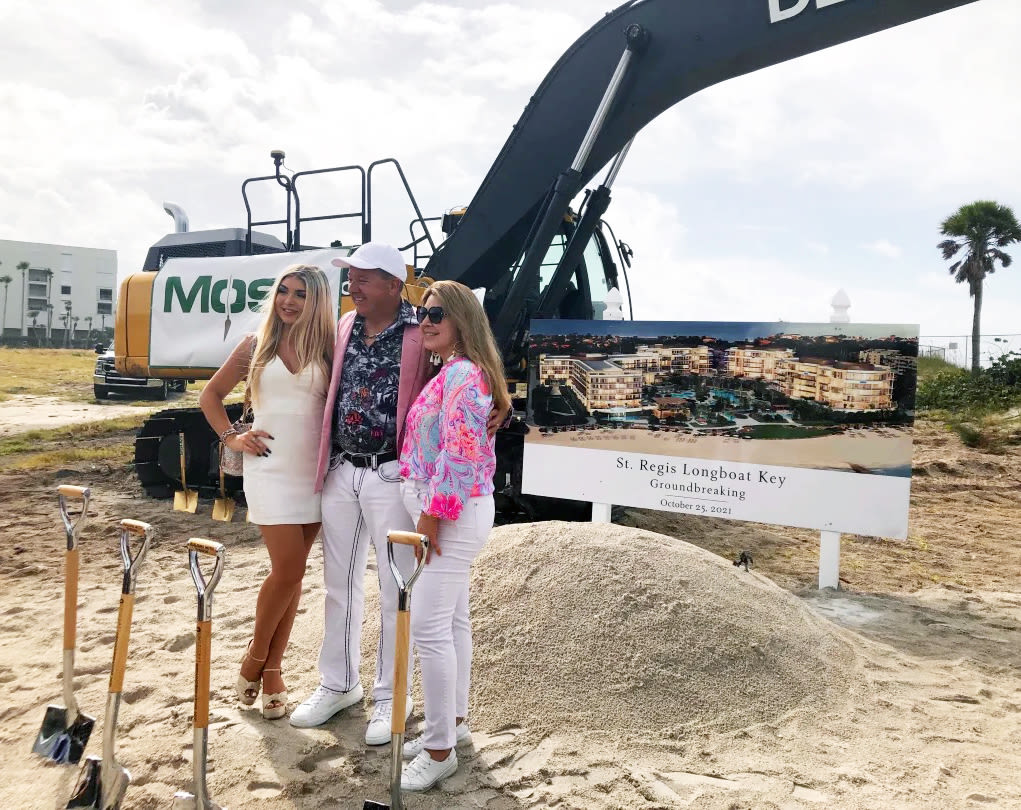Longboat Key's St. Regis Project Has Begun

Rainy morning weather didn’t get in the way of the groundbreaking ceremony for the St. Regis Residences and Hotel on Longboat Key. Developer Charles Whittall poses with his wife and daughter on the site.
Image: Kim Doleatto
Roughly 100 guests huddled beneath an event tent to avoid rainy weather on the 17.6 acres where the Colony Beach & Tennis Resort once stood. After eight-and-a-half years and more than $100 million in legal wrangling, the five-star St. Regis Residences and Hotel project finally broke ground yesterday. (Check out a slideshow of what's to come here.)
Michael Saunders of Michael Saunders & Company, Ken Schneier, the mayor of Longboat Key, and Katie Klauber, the former president and general manager of the Colony, among others, spoke to the crowd. All were happy to begin a new chapter for the sandy site where the Colony was demolished in 2018.
Charles Whittall, president of Orlando-based Unicorp National Developments, stayed with the project despite numerous and costly setbacks. In fact, the groundbreaking hinged on an Oct. 20 meeting with the Town of Longboat Key Commissioners.
Whittall met with them Wednesday for what became the project’s final presentation. An over-allocation of parking for the residential portion and a deficit of 62 spaces for the hotel part of the project were addressed by adding 62 mechanical car lifts that will stack regular-sized cars above each other for a total of 298 spaces.
At a previous Longboat Key commissioners meeting on Oct. 12, commissioners voted unanimously to green light the site plan, minus the event pavilion, which was found to be too close to the erosion line, a line on the beachfront that designates private property from public land. (A 150-foot setback from the coastal erosion line is built into zoning code regulations to prevent potential damage caused by storms. Developers sought to build the pavilion roughly 79 feet from that line.)
“We’re now faced with complying with the setback code or to eliminating it altogether. We don't know what we’ll do yet. We've packed in so many amenities and we don't want to crowd that. It would have been a fixed, four-post, open air structure. But we can have a movable cabana for a single event when it’s not turtle season,” says Zack Justice, Unicorp’s Development Manager.
At the same meeting, a beachfront “Monkey Bar"—another nod to the Colony—was approved for a roughly 109-foot setback from the erosion line.
With such close proximity to the shore, Justice says the project will be include an underground vault dewatering system. “We have a retention area that will keep the water,” he says. “It’s like a huge underground box that has filters made of natural stone materials, and as water seeps through the ground, it collects it and filters it into safe drinking water that will be put into the ground.”
Since sales kicked off in the fall of last year, the cost of building materials and labor have shot up. In fact, during his speech at yesterday's groundbreaking event, Whittall said there had been a $125 million increase in buildout costs. To make up for it, he had three choices: walk away from the project, put it on hold and wait to see if prices went down, or approach the buyers with a 13 percent increase in sales price. He went with the last option.
The price increase didn’t scare off sales: roughly 65 percent of the residences are sold. “Most people were expecting more of a traditional sellout where you're working through sales once it's constructed. It’s unprecedented that we’re seeing such velocity prior to groundbreaking,” says Simon Bacon, executive director of the new homes and condominium department for Michael Saunders & Company, which is representing the developer.
The property will include a 166-room luxury hotel and three, six-story residential buildings with 69 luxury condominiums, with prices starting in the $2 millions. One unit has sold for $20 million. Eighteen one- to four-bedroom floor plans are available, many with sweeping views of the Gulf of Mexico.
So where are buyers from?
Justice shared that 65 percent have out-of-state primary residences, with the largest concentrations outside of Florida coming from New York at 15 percent and Illinois at 11 percent. Bacon says purchasers' ages range from the 30s to north of 70. “Some are wanting it for retirement, some are second homes," he says.
“We expected half of buyers to be investors, and the other half to be homeowners, but almost everyone is planning to spend part of their year here, even though that could change. Owners are allowed to rent for 30 days minimum, if they want,” Justice adds.
St. Regis is part of Marriott International’s portfolio of luxury brands, and residents will be able to access resort amenities at the adjacent St. Regis Resort & Spa. The resort will include spa services and feature a saltwater lagoon, a meandering stream, a heated infinity-edge pool, and an adults-only pool. There will be a ballroom for special events, a piano bar, casual fare at the St. Regis Grille and a beach café and sunset bar.
Residents will also have a private clubhouse with an open air yoga terrace, a wellness center, butler and concierge services, daily housekeeping, on-site pet grooming and chef services, and Bentley and chauffeur service.
"I thought it would come sooner, but great things take time. We'll have it done in about 30 months and it will probably be the nicest resort in Florida," Whittall says.


